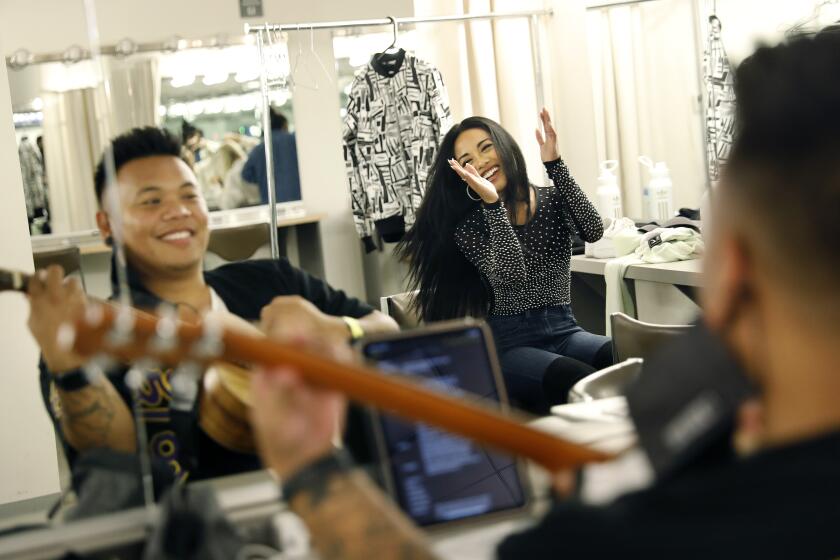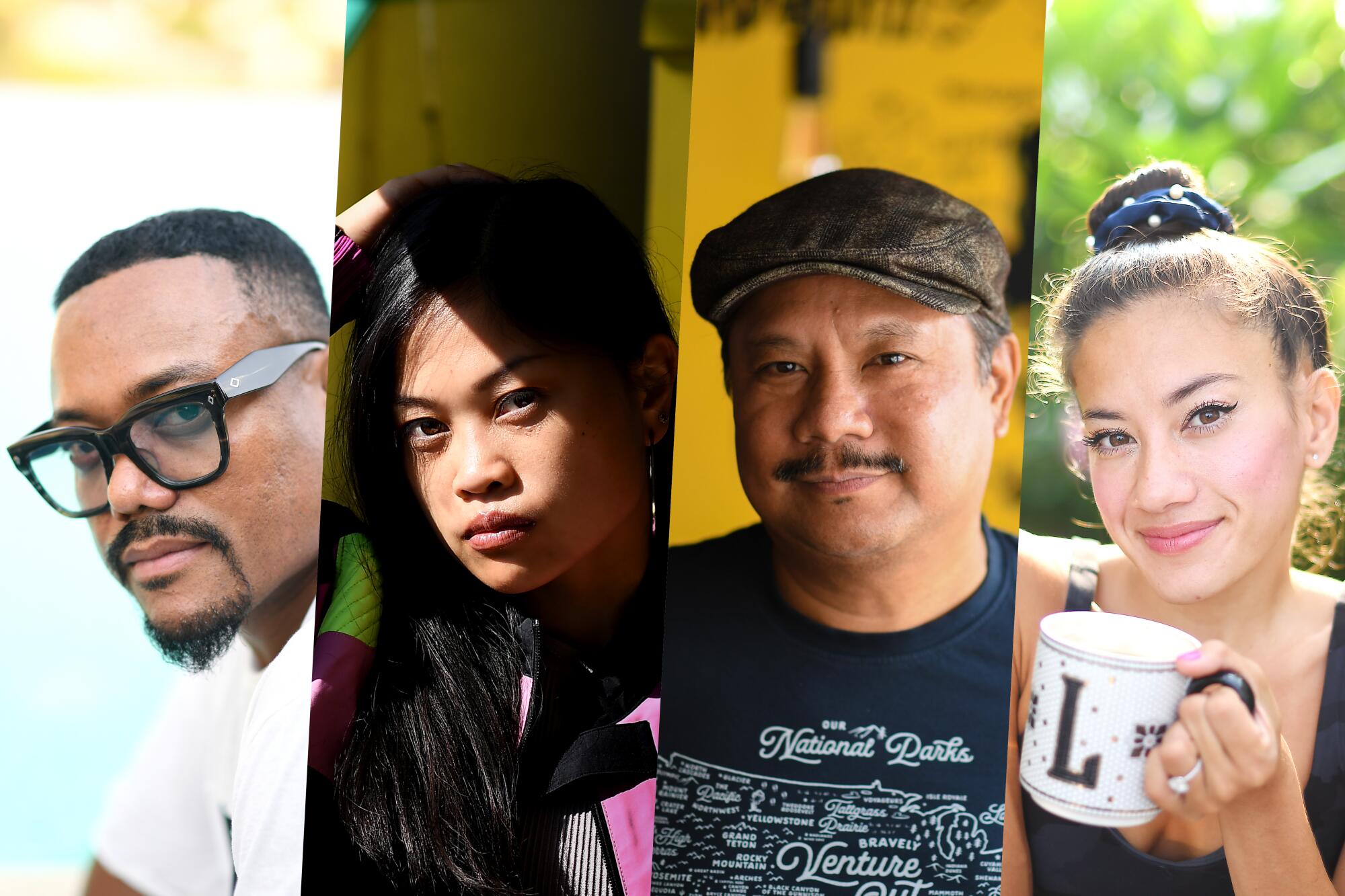
- Share via
You’ve probably heard of Dave Bautista, Bruno Mars and Saweetie. What about Ruby Ibarra, Jules Aurora and Lila Hart? There’s a rich vein of Filipino American talent yet unknown to mainstream American audiences.
On Aug. 29, at the Ford in Hollywood, up-and-comers such as Hart, Aurora and Ibarra from the worlds of music, comedy and dance will share the stage for “A Night of ‘Pinoy’tainment” with established stars such as comic Rex Navarrete and hip-hop superstar Apl.de.Ap of the Black Eyed Peas.
“When it comes to Filipinos, we’ve always been marginalized,” Navarrete says. “We get the bookings to entertain the big banquets and we get to be ‘Asian.’ That was nice in the ‘90s. But now, I think we can call ourselves Filipinos and force people to listen to that. We have one of the most difficult histories, and we hate having to explain ourselves over and over again. Maybe it’s time for you guys to just listen to us doing our thing, and maybe you’ll get it.”
Mabuhay ang pagkakaiba! (Vive la différence!)
The visionary: Apl.de.Ap

Black Eyed Peas star Apl.de.Ap — born Allan Pineda Lindo Jr. — has come a long way from his family farm in Angeles City in the Filipino province of Pampanga. As a boy, he would pump water and deliver it to houses for a peso a bucket, make charcoal to sell or help out on the farm.
“If I wasn’t going to school, I would tag along with my grandfather or my stepfather. We would plant sweet potatoes, corn and rice” and other crops, he says. “At the same time, I would take care of the water buffaloes. You have to ride on their backs; otherwise they would stray and get lost.”
Apl’s life changed, however, when an American lawyer signed up to become his sponsor through the Pearl S. Buck Foundation and in 1986 brought him to Los Angeles with hopes of correcting his nystagmus, defined by the American Optometric Assn. as “a vision condition in which the eyes make repetitive, uncontrolled movements.” The doctors said it was too late to repair his eyes, but with Apl’s mother’s consent, he was adopted by the lawyer and in 1989 moved to Los Angeles. Soon he started dressing like one of his new Filipino American friends, not realizing it was gang attire he was donning. Then his friend offered to “jump him in.”
“I didn’t come to America to fight other Pinoys,” he says. “I came here to have a better life and a better education.”
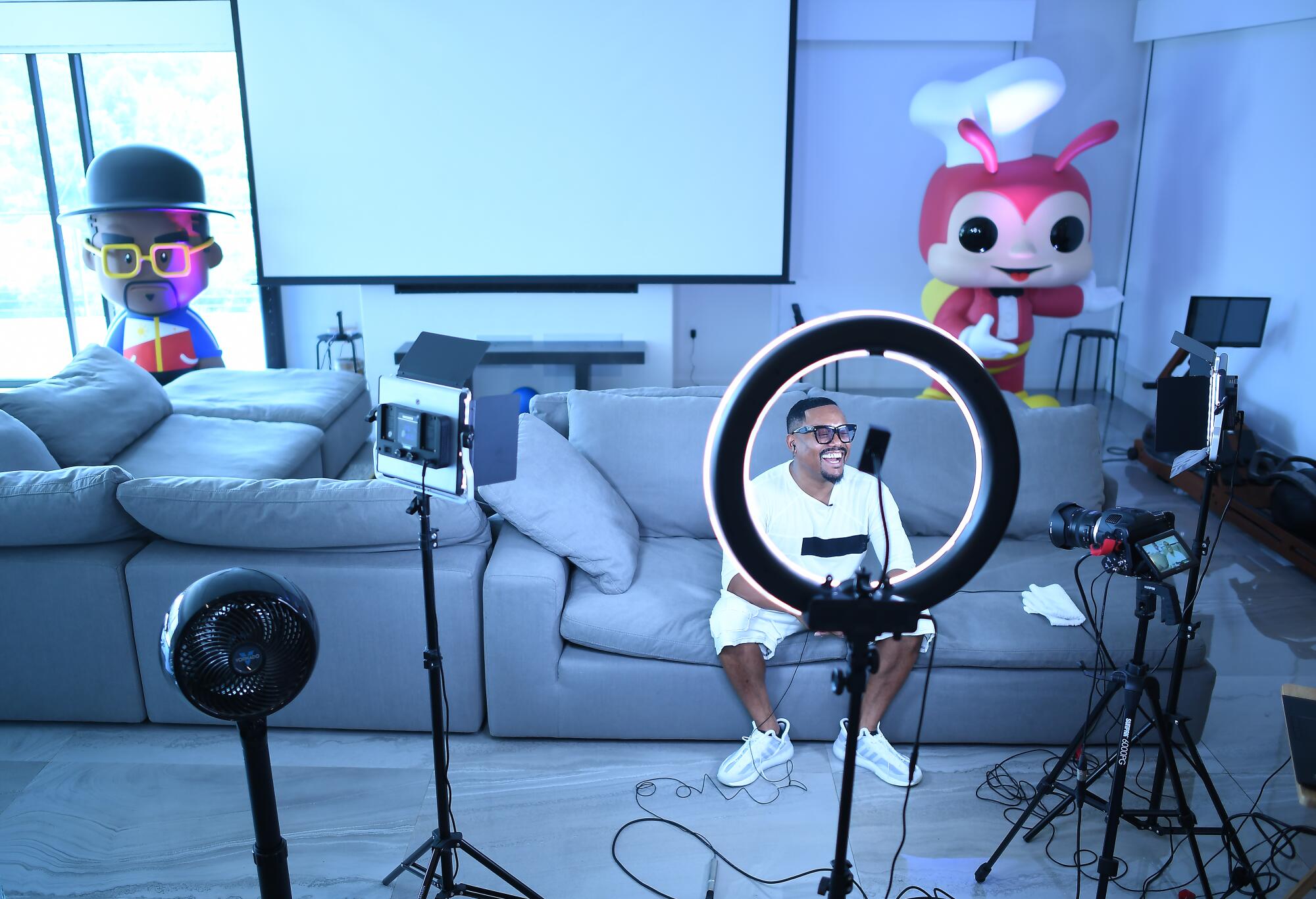
He declined the gang initiation and instead bonded with a kindred spirit, William Adams, through their love of hip-hop and breakdancing. They formed a crew, started rapping together and adopted stage names: Apl.de.Ap (Allan Pineda Lindo de [of] Angeles, Pampanga) and Will.I.Am. The Black Eyed Peas hip-hop juggernaut was born.
“He lived in the ghetto in East L.A.; I come from a different ghetto. Our common goal was to get his family out and support my family. ‘One day, Ap, we’re gonna go back to the Philippines; we’re gonna get Honda Civics and like, put rims on ‘em!’ Later on, we did a whole tour for Honda,” Apl says, laughing. “We had Civics!”
Rappers, comedians, singers and dancers take the Ford by storm for “A Night of ‘Pinoy’tainment.” Here’s what it looked like behind the scenes.
The Peas, of course, have more than Civics. They’ve sold an estimated 80 million records, powered by massive hits “Where Is the Love?” and “I Gotta Feeling” and collected six Grammys. Earlier this month they released a new single, “Hit It,” with Saweetie and Lele Pons.
Apl’s newest Los Angeles home is luxurious, with spectacular views and a room dedicated to the toys he collects, including the miniature jeepney replicas he acquires every time he visits the Philippines. (He intends to combine them one day into an art project representing a full-size jeepney.) But he remains down-to-earth enough to answer his own door and rides a bike to the Hollywood gym where Manny Pacquiao trains.
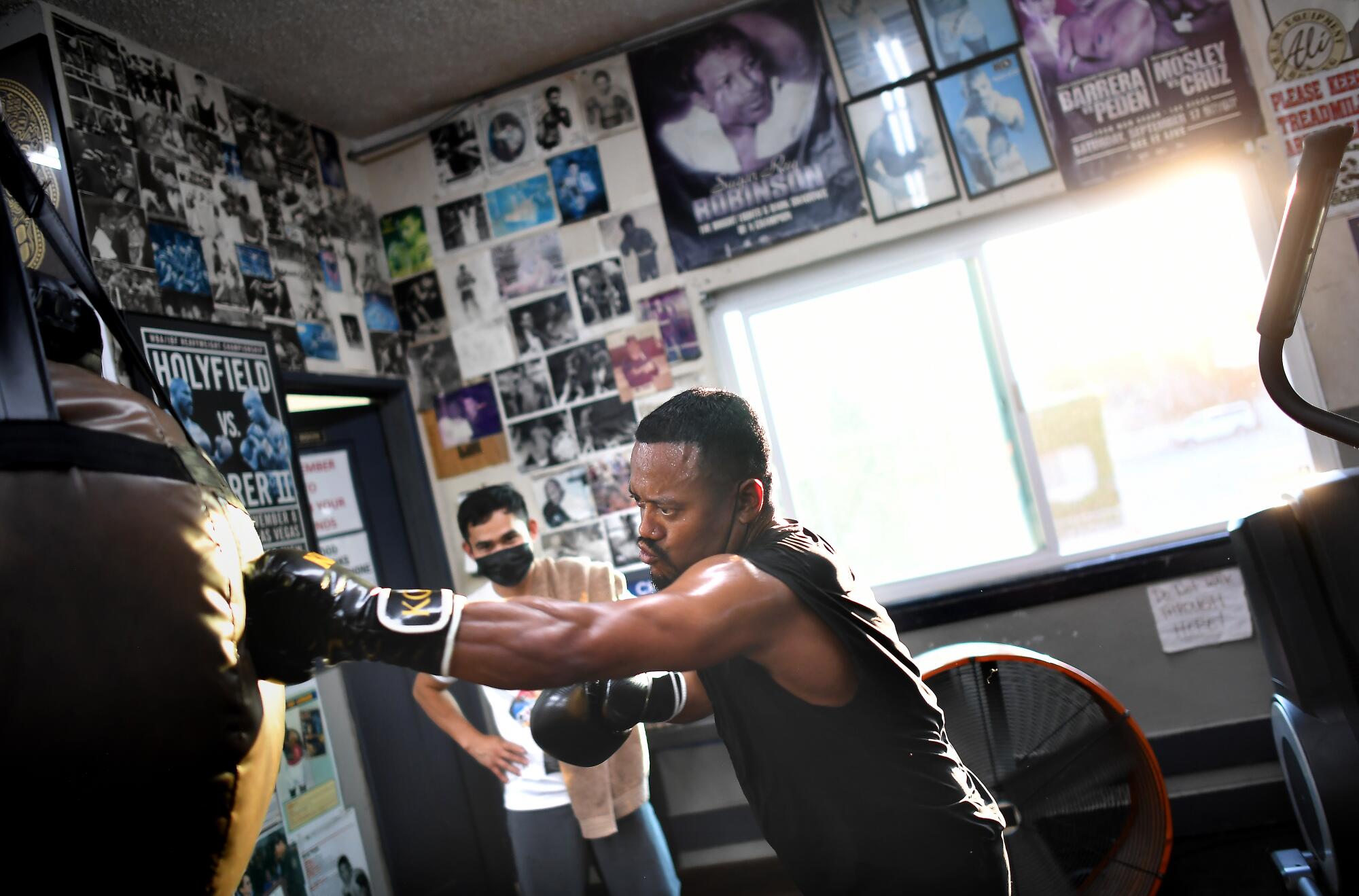
Back in the Philippines, Apl built a massive compound for his mother — not in some swanky Manila enclave, but where he grew up. And with the Peas, it has become a tradition to include one Tagalog song per album, including the anthem “Bebot.” He even found the Peas’ most recent singer, J. Rey Soul, when he was a judge on “The Voice of the Philippines.”

Apl never strayed far from his family tree. “I’ve never really talked to my mom about” her decision, he says, to allow him to move to America. He pauses, admitting it’s something he hasn’t taken much time to think through. “That’s a common thing for Pinoys, to go abroad. I just did it at a younger age, but we always have to go abroad to earn a living and send money back. Me and my mom had that understanding. I’m old enough to remember to go back home: This is my opportunity and it may not come again.
“I thought it was gonna be Disneyland every day. Then reality sets in.”
Weeks after his move to America as a teen, he cried about his homesickness to his best friend, Will.I.Am, who said to him, “Don’t worry about it. We’re gonna make it, and we’re gonna go back to the Philippines and perform in front of your family.”
It wasn’t a future that was easy for him to see as a young man. Which is why he’s tried to give other young Filipinos the chance to envision a better path.
Through his Apl.de.Ap Foundation, he has built 34 classrooms throughout the Philippines and put 37 kids through college. His “Apl of My Eye” program has donated two retinal cameras to hospitals far from Manila so that vision conditions requiring immediate diagnosis can have a chance to be corrected in time. They’re fundraising for a third.
“When I started my foundation,” he says, “I wanted to do things [related to] what I’ve been through, like getting an education.”
Over time, the rapper has had procedures to improve his vision. He laughs as he describes the latest operation, which he says upgraded his seeing by 5%; it sounds like a nightmarish scene out of Luis Buñuel’s “Un Chien Andalou.”
“I used to wear contacts,” he says, but because of his eye movements, “they would slide around. Now they’ve inserted the lens in my retina. They did a little slit right here. They gave me a teddy bear and everything. I’m fully awake while they’re slicing my eyeball.”
That’s one way to sharpen one’s vision.
The Filipina Avenger: Ruby Ibarra
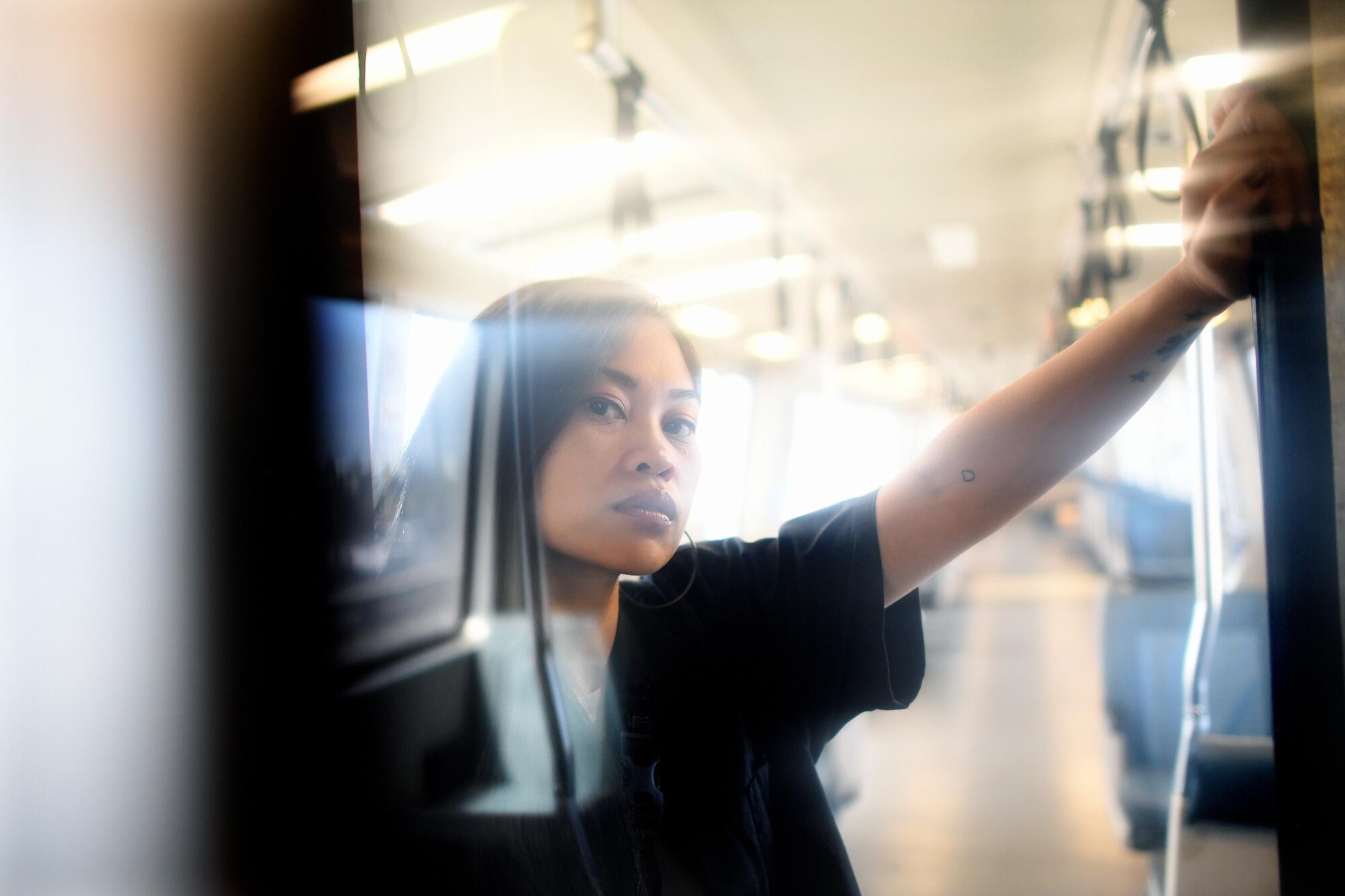
In conversation, Ruby Ibarra is bright, focused, funny and friendly. But she has no problem with anger, especially righteous anger. In fact, when it comes to her music, the rapper embraces that idea.
“I’m a big fan of artists like Rage Against the Machine, and they’re driven by a lot of anger and fueled from a lot of passion. I don’t shy from that description when it comes to my music because I feel like, as a 1.5-generation Filipino American, and especially as a Filipina, I have every right to be angry,” she says.
Witness some of the rhymes from her song “Us”: “Yo f— a story arc if it don’t involve no matriarchs” ... “But we puttin’ our heart into darkness / They puttin’ these pigs into office / Oh you thinkin’ you schoolin’? / But you hella lost ‘cuz you Betsy DeVos while I taught this.”
“I was born into a political identity that already means you’re colonized,” she says. “It means you come from a long history of having been impacted by imperialism by the U.S., so of course my music’s gonna reflect that.”
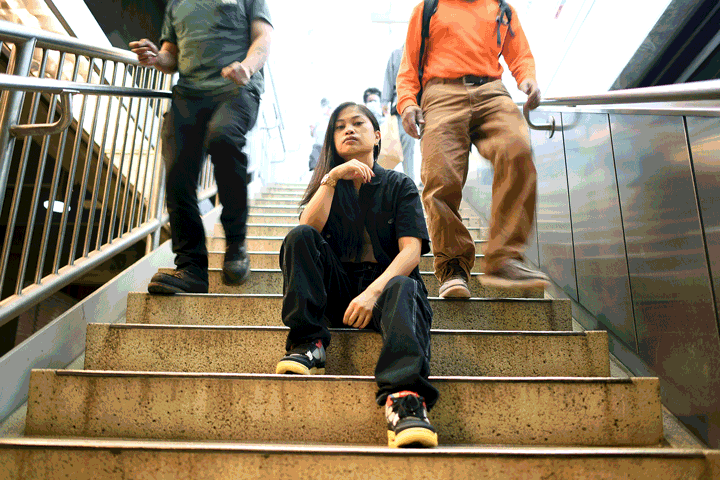
Ibarra was born in 1991, in Tacloban City. When she was 4, her family (mother, father, younger sister) moved to San Lorenzo in the Bay Area.
“I’m very thankful, thinking about my quote-unquote ‘origin story,’ that it was the Bay Area,” she says, “because you can step outside and hear a different language or turn around the corner and come across a food from a different culture. It made that transition of being in an entirely different culture a little easier for me at such a young age.”

She may be the recording artist in the family, but she insists her younger sister, Donna, is the far-better singer.
“A lot of my memories of living in the Philippines involve food or music — conversing over food or building relationships over music. My mom, my cousins, aunts and uncles all played the guitar. Unfortunately for me, I’m the only one that can’t carry a tune in my family. That also pushed me: I gotta find my genre so I can join you all on the karaoke!”
She grew up listening to the hip-hop titans of the ‘90s and early aughts — Tupac, Eminem, Wu-Tang Clan — but was drawn at an early age to Filipino hip-hop pioneer Francis M (Francis Magalona), who rapped, she says “about celebrating being Filipino, the importance of community, the importance of remembering where you come from.”
But when it comes to someone who expresses her two interests (science and hip-hop), she cites ... Bill Nye, the Science Guy.
“I saw one of his segments where he was talking about molecules and atoms and doing it in a way where he was rapping the information. As a little kid, that was mind-boggling. ‘Oh, my God, I’ve never heard Tupac or Wu-Tang talk about these topics!’ ”

At UC Davis, she majored in biochemistry and molecular biology, harboring a passion for rap and hip-hop that didn’t turn into a vocation until she heard “The Miseducation of Lauryn Hill.” “I felt not only empowered, but also inspired to tell my own story,” she says. “Here is this woman of color, absolutely talented, so fierce, so unfiltered. It provided a soundtrack to me coming into my womanhood.”
In 2012, she released her first mixtape, “Lost in Translation.” It took five years to drop her first album, “CIRCA91.”
“When I was making the mixtape, I think I was still focused on the technicalities of hip-hop, rather than the storytelling. On ‘CIRCA91,’ it was absolutely me — me putting down my guards and inviting people into my life story.”
That album includes her best-known song, the women of color anthem “Us” (a collaboration with Rocky Rivera, Klassy, & Faith Santilla): “Island woman rise, walang makakatigil [Nothing can stop] / Brown, brown woman, rise, alamin ang yung ugat [Find out the root] / They got nothin’ on us (aye!) / Nothin’ on us (aye!)”
“This teacher who was Pinay said she had never come across a music video like that before where she was seen and her story was told. At the end of the school day, she asked her three Filipina students in her class to stay behind, and they closed the doors and had a private screening. She said she was nearly brought to tears, seeing them at a young age, seeing themselves on screen like that.”
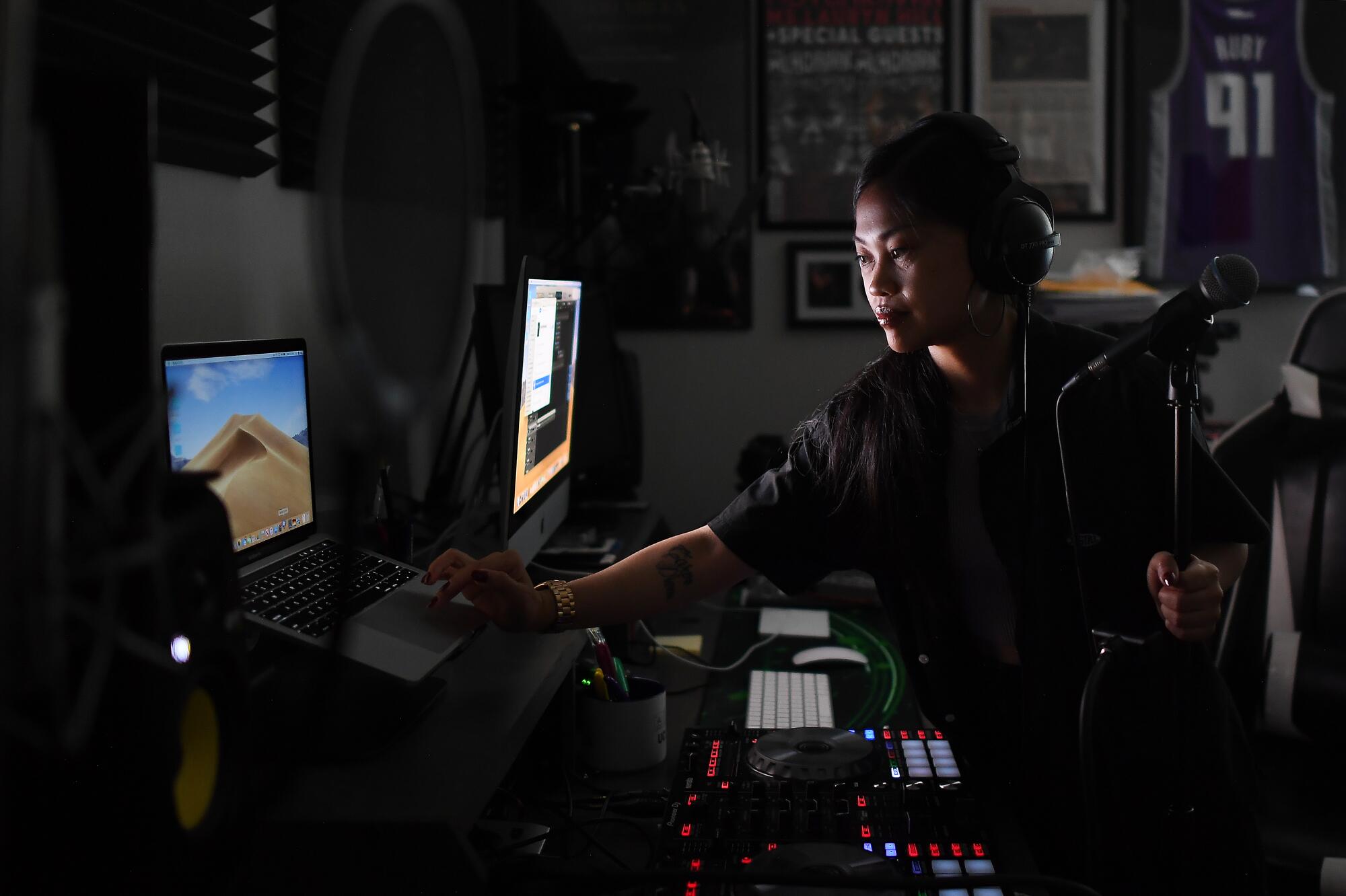
She calls joining the bill at the Ford on Sunday a “no-brainer,” considering who’s involved. “Apl has represented our community very well; he’s always going to be one of those musical GOATs for the Fil-Am community. Who doesn’t know the song ‘Bebot’ when it comes on? Seeing [host] AJ Rafael and Rex [Navarrete] on the lineup, I’m super humbled to be part of it.”
After finishing touring for the album with just her and a DJ, she decided to take her sound in a radically different direction. She assembled a jazz-inflected band, the Balikbayans (who won’t be at the Ford): “It was relatively easy. I was already friends with the different people; it was just a matter of bringing everybody in and creating the Filipino Avengers.
“What makes me want to be a better artist is seeing all these Filipinas killing it right now. We have [weightlifter Hidilyn Diaz], who brought home the [Olympic] gold recently and [rapper] Saweetie, who has her very own McDonald’s meal now. This is a time when so many Pinays are killing it and I’ve gotta represent.”
The truth teller: Rex Navarrete

It’s no exaggeration to call Rex Navarrete the best-known Filipino American comic; he has played major venues in the U.S. and around the world for more than 30 years. He says now he had no choice.
“I really wanted to become a lawyer or a doctor, but my parents crushed my dreams and said, ‘You need to go into comedy. Don’t shame this family; be an artist!’ ” he says slyly.
The truth, of course, is he had to hide his passion for standup from his classic immigrant family — the parents who arrived in the U.S. in the early ‘70s in search of a better life; the chemical-engineer father who parked cars until he could get a job in his field.
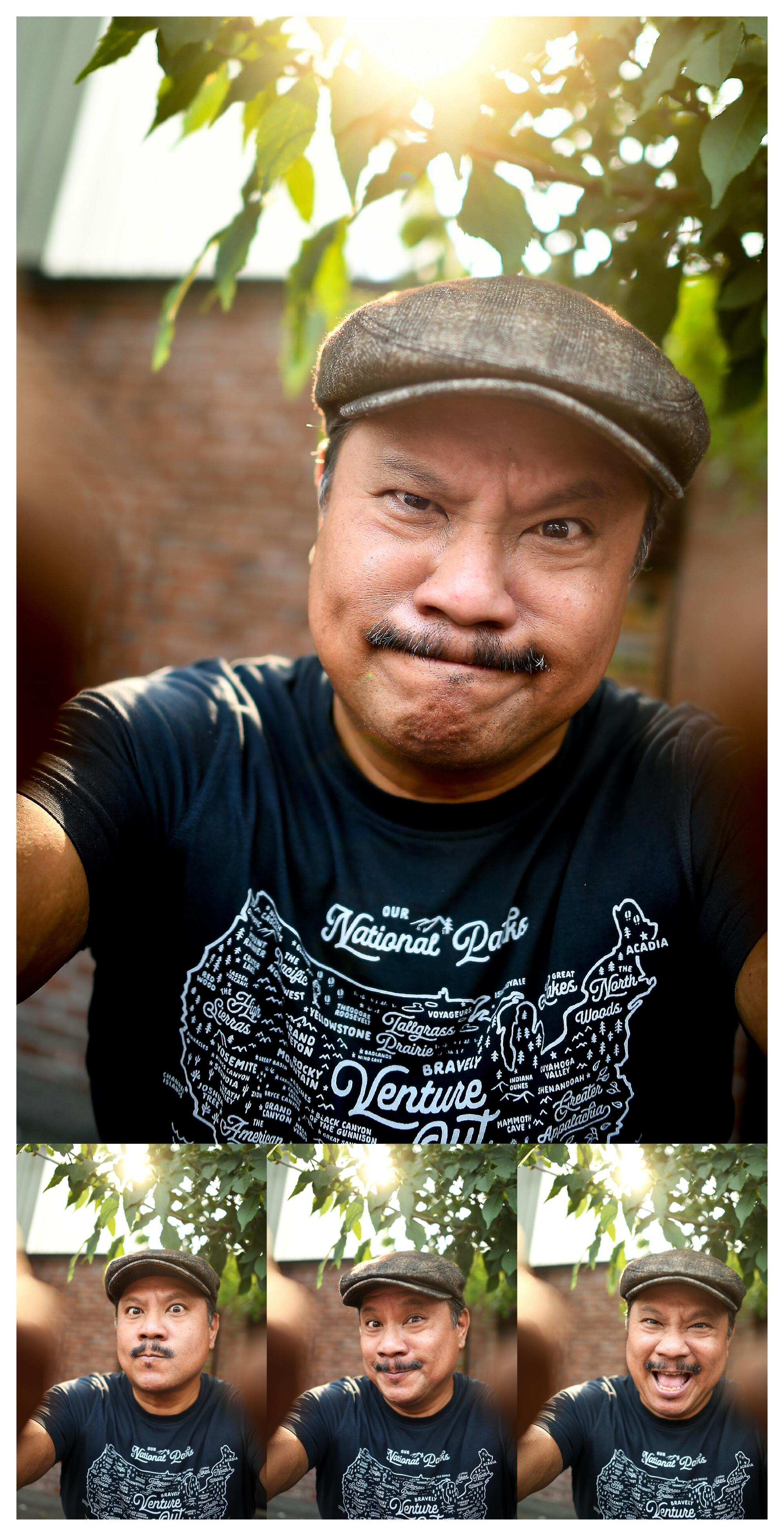
“My parents didn’t know I was doing standup for two years,” he says, describing the thrill of making enough money for gas, just for telling jokes: “$50 was big in ’92.”
Navarrete was outed when he took part in a person-of-color standup competition in Berkeley that got coverage in a local paper.
“It’s been over 31 years, and they still haven’t accepted it.”
Navarrete, born in the Philippine province of Cavite, was raised by his grandmother for his first two-plus years while his parents made their way in America. He joined them — and his new baby sister — in Chicago (“Straight from the province to Chicago blizzard”) before the family settled in South San Francisco.
“I watched everything I could, every cartoon, to sound as American as I could. Maybe it helped what I do today: mimicry, voice work, acting and writing comedy. But back then, it was a matter of surviving.”
He has done considerably better than survive.
“All these countries I never thought I’d travel to — just to tell jokes. There are these half-German, half-Filipino kids who discovered me on the internet,” he says.
Navarrete is known for his character bits — he cites Eric Bogosian, Richard Pryor and Eddie Murphy as influences who taught him he could embed in a character rather than just set up punch lines — and for his routines about Filipino culture. In one bit about Pacquiao, the world’s most famous Filipino, he explains the correct pronunciation is “Puck-yow,” which might account for why Pacquiao had to learn to fight at a young age in a country where F’s and P’s are sometimes switched.
“You always ask yourself as an actor of color or a comic: Are you trying to reach a wider audience — or a whiter audience?” Navarrete says. “My thing has always been ‘I’m gonna reach my audience.’ ”
And after years, he says, of Filipino Americans being marginalized, it’s time for Pinoy entertainers to stop worrying about explaining themselves: “ ‘Hey Rex, is your material gonna cross over? Will my friend or my spouse who’s not Filipino gonna get it?’ I’ll say, ‘Do they speak English? Because I do my whole act in English. If I speak some Tagalog words, I will not leave you out.’ No one is left behind.”
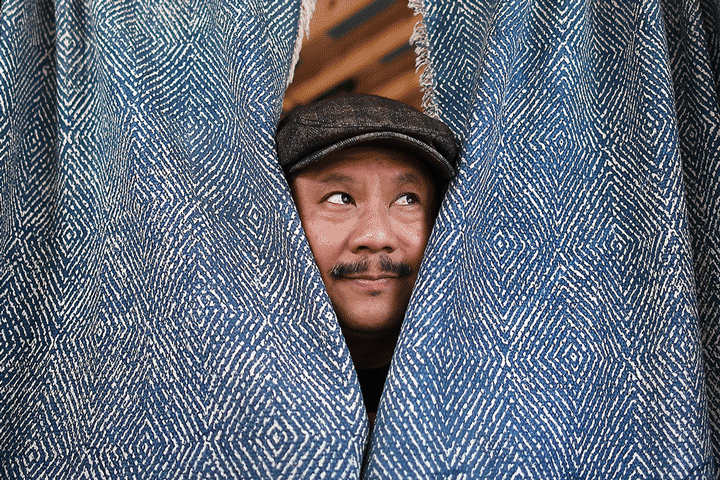
If that sounds as if there’s a bit of an edge to what he does, there is. Navarrete can start a bit about Filipino food (“We love every inch of a pig. ... If there was an opportunity to deep-fry the ghost of a pig, we would”) and sprinkle in some truth seasoning about colonization.
“I’ve always been Filipino since the beginning, unapologetically — ‘You gotta play the ambiguous brown or Asian American’ — Sorry, I’m not doing that. That was my mission statement from the beginning: ‘I’m gonna be a Filipino.’ A Filipino American doing standup, doing political commentary, satire about the Filipino experience in this country, as an immigrant as well.
“Sometimes comedy’s like a spoonful of honey. It goes down easier than a spoonful of vinegar,” he says, then cackles. “But Filipinos manage to sneak the vinegar in there.”
The unsinkable: Lila Hart

“I’m as tall as a parking meter,” Lila Hart likes to say in her act. Indeed, the Filipino American comic stands 4 feet, 6 inches.
As she leads a tour of the San Fernando Valley home she shares with her fiancé, she bursts with energy and positive vibes as she encounters a cat or turtle or bird in her menagerie, as if discovering them for the first time and basking in love.
On the building’s rooftop the couple have cultivated a jungle of citrus and plumeria. She proudly presents a Granny Smith apple tree they transplanted after spotting it in a CraigsList ad, about to be abandoned: “We didn’t think it would survive, but it did,” she says. “The plants we rescued mean the most to me because we gave them a second shot at life.”
She knows a little about getting more life than expected.

Hart has had spina bifida, a spinal condition, since birth. “They said I’d be unable to walk and have difficulty learning — there would be a lot of challenges in my life,” she says. “I had multiple back surgeries before the age of 5. In kindergarten, I was in a wheelchair.”
Lo and behold, she’s living her best life, having just turned 30 and gotten engaged to a doting beau she met on the standup circuit.
“I walk with a little bit of a limp and a lean. I’ve become more confident,” she says, though confidence doesn’t sound as if it were an issue for the student body president of her elementary and middle schools. She graduated from Washington State University with a degree in broadcast production and a minor in political science, intending to become a news anchor (“I figured if I were at a desk, it wouldn’t matter how small I was,” she says). She moved to Los Angeles with that career in mind but felt interviewers couldn’t get past her appearance.
“Being discriminated against,” she says, “led me to standup.”

Hart had attended any number of what she calls “disability events,” where she found herself an inspiration to parents whose kids had similar diagnoses. At one, she met Devon Ferguson, a few years older, with spinal muscular atrophy.
“He was the kindest person; you could talk with him about anything. His face would light up when you walked in the room. On my 25th birthday, he gave me a painting of ‘The Little Mermaid.’ He would wear one of those caps [with a paintbrush attached]; he would paint with his forehead.”
He was the first person she told of her decision to fling herself into the world of standup comedy.
“He was super excited, super happy about it. I’d practice in front of him; it would just be me and him,” she says. “That material was about spina bifida, being disabled. I was ready to speak about it and own it. This is who I am, it’s part of me and I’m ready to tell my story. I was 24.”
Hart and Ferguson were peas in a pod for four years, until he died at 33. His funeral happened to be the same day as her gig at a Narcotics Anonymous meeting.
“Oh, yeah, I’m sober,” she tosses off, acknowledging troubles with drugs and alcohol. She stumbles, emotion catching in her throat. “Speaking at Devon’s funeral that morning, he was such a big part of my growth as a person and understanding my own disability, and then to perform in front of this big audience at Narcotics Anonymous who were struggling with addiction, and myself, who has had my own struggles — I felt like he was with me.”

Hart’s comedy is unrestrained. She talks about politics, sex, life with spina bifida and being Filipina. Empowerment is definitely a theme in her story, even if it has brought her into conflict at times.
One of her first jokes used a word related to her height that led to her being taken to task by the ladies of the Lifetime show “Little Women: L.A.”
A spokesperson for Little People of America told The Times, “People with dwarfism consider the ‘m’ word as being an offensive slur.”
“My intent is not to hurt anyone; it’s to tell my story. So I used the word that hurt me in a way that I can find comedy in and heal from. We all have our own insecurities and the path we have to go on to heal, and for me that’s been through comedy. It’s just gold. It feels amazing,” she says, and there’s that smile again.
“It’s better than any drug I’ve ever done.”
'A Night of "Pinoy"tainment'
When: Sunday, Aug. 29, 7:30 p.m. (Gates open at 6 p.m.)
Where: The Ford, 2580 Cahuenga Blvd. East, Los Angeles
Tickets: The Ford website or (323) 850-2000
About this story
This piece was photo edited and designed by Calvin B. Alagot. It was photographed by Christina House, written by Michael Ordoña, edited by Laurie Ochoa and copy edited by Wendy Fawthrop. Additional editing by Kate Kuo, Elena Howe and Don Ragland.
More to Read
The biggest entertainment stories
Get our big stories about Hollywood, film, television, music, arts, culture and more right in your inbox as soon as they publish.
You may occasionally receive promotional content from the Los Angeles Times.
